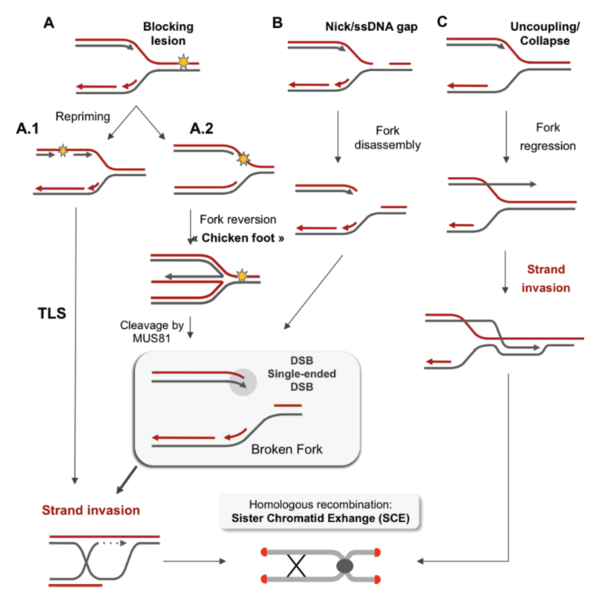Image: Replication fork restarts by homologous recombination following replication stress

Description: (A) Model of repair of blocking lesions. (A.1) DNA adducts obstruct DNA synthesis by replicative DNA polymerases. Fork progression on a damaged template might involve a repriming event downstream of the damage, which leaves a ssDNA gap behind the moving fork. Rad51 then nucleates on the ssDNA gaps and promotes the recombination with the sister chromatid to seal the gap. Other mechanisms might be involved in the bypass of DNA lesions such as translesion synthesis (TLS). (A.2) Model of fork regression at a stalled fork: A slowing down of fork velocity or fork arrest leads to a transient uncoupling of the helicase and polymerases, thus exposing ssDNA at the stalled fork. The fork reversion forms a “chicken foot” structure (i.e., the fork and the nascent strand, which is complementary, being annealed together to form a four-way junction). Cleavage of this structure might involve MUS81 and leads to single-ended DSB formation. (B) Model of broken-fork repair. A replication fork can be converted into single-ended DSBs following the passage of the fork through a nick or following cleavage by an endonuclease. The single-ended break is then resected and Rad51 nucleates on the exposed ssDNA and promotes recombination with the sister chromatid. The 3' end of the invading strand primes DNA synthesis, and the replisome has been proposed to be rebuilt from the extended D-loop structure. (C) Model of fork restarts at a collapsed fork. Fork collapse might arise from a stalled fork where the replisome fails to be maintained in a functional state or when the replisome encounters physical obstacles such as tightly DNA bound proteins or RNA/DNA hybrids. Resection of nascent strands might help the fork to regress (i.e., the fork moving backward without the annealing of nascent strands) and thus allow the 3' end of the nascent strand to be extruded. Rad51 nucleates on the exposed ssDNA and promotes recombination with the parental DNA duplex. The replisome could again be rebuilt from the extended D-loop.[1]
Title: Replication fork restarts by homologous recombination following replication stress
Credit: https://doi.org/10.3390/genes6020267
Author: Camille Gelot, Indiana Magdalou, and Bernard S. Lopez
Usage Terms: Creative Commons Attribution 4.0
License: CC BY 4.0
License Link: https://creativecommons.org/licenses/by/4.0
Attribution Required?: Yes
Image usage
The following page links to this image:

